Orchid baby: what is it and how to plant it at home?

Orchid is a very beautiful flower that can beautify almost any setting. But this lovely plant differs not only in its beautiful appearance, but also in its "capricious character". Caring for any type of orchid is not an easy task, especially if a novice florist is engaged in this. It is very important to water, fertilize and plant the orchid correctly. In the latter case, many people use flower babies. Today we will consider in detail what it is and how an orchid can be planted at home.

What is it?
Before considering step by step how you need to properly plant this luxurious flower, you need to figure out what the children mentioned earlier are. So, we must take into account that the baby of this plant appears on the peduncle after the flowering stage. If you look closely at the stem, you can see small tubercles with a scaly coating. These are dormant kidneys. The orchid baby begins to develop on these elements. However, there are also exceptions to the rule.
Also, this part of the flower is capable of ripening from the axils of the foliage, despite the fact that the children are still root processes.

When can you transplant?
Reproduction of orchids is a rather difficult stage. Here the florist should exercise the utmost care and vigilance. It is also not recommended to rush. It is necessary to plant the baby of this flower at the right time so that in the future there will be no problems with the young sprout. Consider all the main points that should be considered when choosing the time to transplant this spectacular and demanding plant.
- One of the indicators of readiness is regrown rhizomes. Until you notice them, you do not need to touch the process, otherwise it simply will not take root and will not take root in a new place. The roots must be healthy and strong. Their length should not be less than the 5 cm mark. Please note that the larger and longer the roots of the child, the more likely it is that jigging to a new place will be successful, and the plant will definitely take root in unfamiliar conditions. You do not need to deal with the separation of the process if you notice less than three roots on it.
- You should also pay attention to the number of true leaves. At least 5 flowers can form on young plants. After their separation from the base, the chances of survival in these specimens remain quite high. It should not be forgotten that high-quality and healthy leaves are the proper nutrition of the plant from sunlight, as well as its respiration.
- It is also necessary to take into account the period during which the baby was on the mother plant. This period should not be less than 8 months. Experts generally recommend waiting until about a year has passed after the appearance of the shoot. Building up the rhizome system is a long and difficult process.
It will be necessary to properly prepare all the necessary items - a pot, soil, tools.
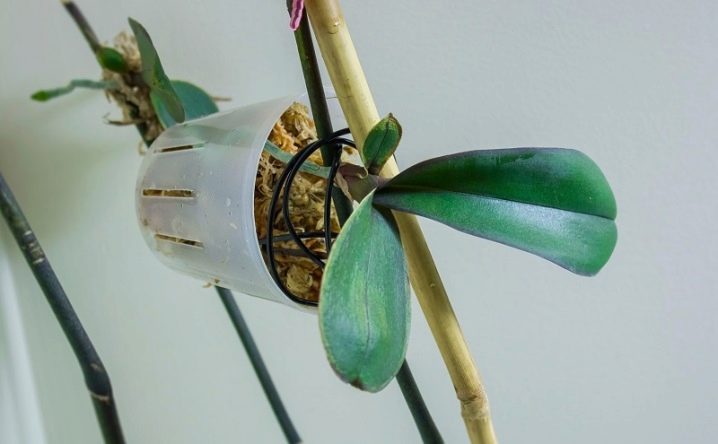
If you want to properly plant and propagate this gorgeous plant, then you must take into account all the above nuances of the transplant period.Do not rush with this procedure, otherwise the baby may simply not take root, since its root system will not be fully developed. In order for the roots to grow back, these elements usually take at least six months. Up to this point, the baby feeds on the mother plant.
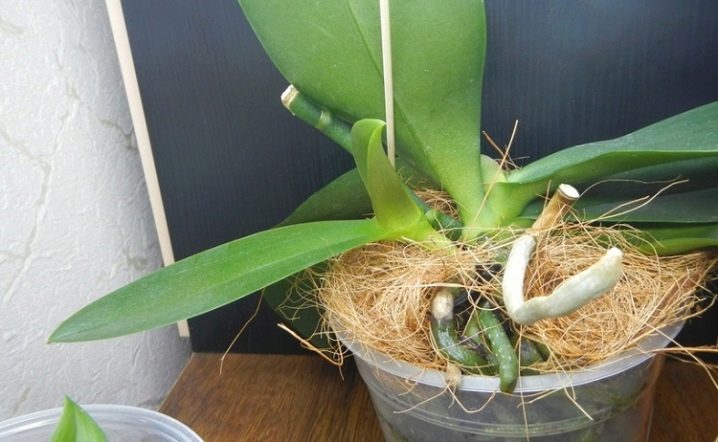
How to separate a baby from an orchid?
If the moment for the separation of the children has come, then it is allowed to boldly proceed with further actions. This must be done very carefully and in accordance with all the rules so as not to harm the flower. The baby is separated in different ways based on where it appeared - on the peduncle or the axil of the leaf. Let's take a closer look at how to properly separate this part of the plant in different situations.
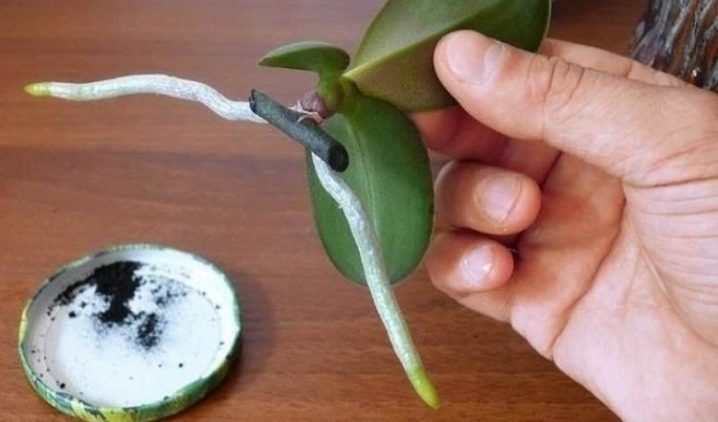
On the peduncle
In order to properly separate, and then transplant, the baby that appears on the peduncle of the mother plant, she needs to be allowed to grow up. Several leaves should be formed at the orchid process. As mentioned above, shoots should not be separated until their rhizome system is sufficiently developed.
Leaves on babies in most cases are formed early, but the formation of roots usually takes more time - several months. When the roots have reached a mark of 3-4 cm, it is allowed to proceed with the separation and transplantation of young shoots. They should be trimmed very carefully using peeled and sharp scissors. These parts should be cut off, keeping about a centimeter from the mother plant on both sides. After that, the baby becomes a separate living organism.

Basal
At home, it is possible to separate those orchid babies that have formed on the rhizomes. In this case, you should also act as carefully as possible so as not to harm either the young roots or the mother plant. To do this, you will need to remove the upper layer of the substrate. After that, you should see if the child has developed its own healthy root system. If one is present and is in good condition, then it will be necessary to carefully cut the spine with clean scissors, which connects the baby and the mother base itself.
You need to cut the connecting part, keeping one centimeter from the sprout. Proceed with care, taking your time to avoid damaging the roots, as this can lead to serious plant problems. After that, the baby can be taken out of the pot.
This should also be done with the utmost care.

From the axil of the leaf
In order to correctly cut off a new sprout that has appeared in the leaf sinus, it will be necessary to grab another 1-1.5 cm of tissue from the mother plant with a pruner. Cut sections will definitely need to be properly processed. In the course of the reproduction of orchids with shoots, unforeseen situations may occur that require immediate resolution.

No roots
There are situations when a baby grows so that it does not have a standard root system. In such a situation, it is advisable to wait a little longer. Perhaps roots are forming, it just takes a little more time. Of course, it is permissible not to wait too much time, but to immediately separate and plant the baby in a substrate prepared in advance. But in the circumstances described, it will be necessary to create all the necessary conditions for the further development of the roots.

To the greenhouse
If it is planned to transplant a new sprout into greenhouse conditions, then it is allowed to separate it at the age of four months, without waiting for the development of the roots. The flower is transferred to a pre-prepared substrate made from crushed pine bark. The plant will need to be moved to a greenhouse and sprinkled with water every day. This procedure is not prohibited to alternate with treatment with a suitable fertilizer composition.
However, such procedures should be carried out exclusively during the daytime. In this case, liquid must not penetrate into the center of the outlet. It is imperative to make sure that there is no destructive excessively wet substrate. It should dry for a couple of hours. In order for orchid children to take root in a greenhouse environment, knowledgeable flower growers recommend using live moss. A cut-off flower baby is laid on top of it.

Into styrofoam
For further rooting in a similar way, you need to take and cut off a not too large piece of foam in advance. After that, it is necessary to make a few holes in it, in which the bases of the children can fit. The flowers are fixed and placed in a container filled with water. The base for the miniature orchid should be positioned above the liquid. This will create the ideal moisture level for the root system to grow. In order to raise the humidity level of the air, it is permissible to close the container with water with a plastic bag or plexiglass.
Once the roots have formed, the small orchid will need to be transferred to a substrate made from pine bark.

Basal
These sprouts do not have their own rhizomes. They are fed through the main stem from the roots of the mother plant. If the indicated baby was formed on your orchid, then it cannot be separated. It's just that two flowers will now develop and bloom in a pot, and not one. Often, a basal type baby appears at the site of the growth point of the phalaenopsis. In most cases, this happens when it dies. The said baby will simply give rise to the development of a new plant.

How to transplant into a substrate?
If the separation of the sprout from the main plant was done correctly, and the shoot acquired a root system, then it is permissible to safely proceed to its transplantation into the substrate. First, a young sprout must be prepared for transplanting into another pot. For this purpose, the following procedures are carried out.
- Layers are postponed to soak for 15 minutes. Before that, it is permissible to dissolve growth hormone in water. In this way, you will be able to guarantee faster and more noticeable growth of the rhizomes.
- Moistened rhizomes during transplanting are not subject to injury. In addition, they are much easier to put in a new pot of substrate.
Before you put the baby in a fresh place, you will need to carefully lay out a drainage layer on the bottom of the selected pot. For this, you can use ceramic shards or vermiculite. Many people use expanded clay, but not all growers recommend using this material, since it often contributes to the accumulation of moisture, and this will definitely not benefit orchids. After laying the drainage, the separated plant can be planted.

Let's consider step by step how it should be done correctly.
- In the prepared container, the process will need to be placed in such a way that its lower leaves are located above the surface of the soil, and not buried in it. Handle the baby and the leaves very carefully at the time of transplant.
- Next, the substrate will need to be poured in portions, little by little. In this case, the pot will need to be gently shaken and tapped so that the soil can be optimally distributed between the roots. The substrate usually does not need additional compaction.
- During the first few days after transplanting, the flower does not need to be watered if in the future you plan to grow it beautiful and healthy. On the cut off area, the children must definitely dry out.
It is recommended to place an already planted young orchid in partial shade at first. After that, it will be possible to move the container with a flower to a place where diffused light is present. Do not, under any circumstances, place your flower baby in direct ultraviolet light. If it is a window sill or a table next to a window, then the latter must be closed with a curtain. In the opposite situation, the orchid will not be in the most comfortable conditions for it. The flower will surely bloom and look spectacular if it is properly cared for.
You should not constantly move the pot with the baby from place to place - orchids do not like this.
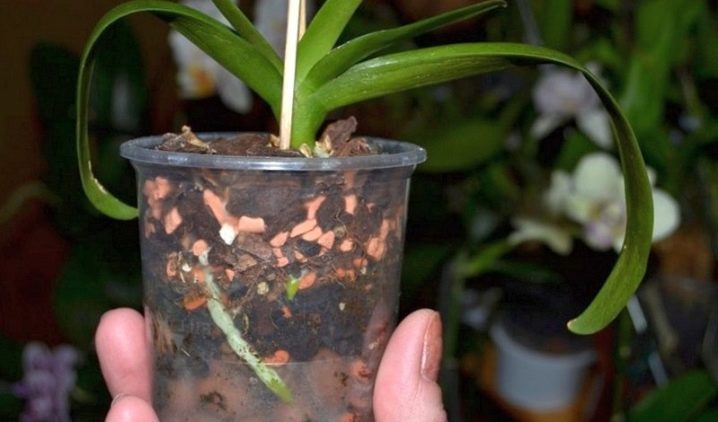
Can it be separated from a blooming flower?
Many novice flower growers, who are first engaged in planting such a capricious flower as an orchid, ask themselves the question: is it possible to separate his baby from a blooming flower? Experts recommend not to rush, but to wait until the orchid bloom is over. This is due to the fact that during this period the roots of the child are still poorly developed, therefore, it will be too difficult to root the shoot in a new substrate.
In addition, for a blooming orchid, such procedures can be serious stress.

How to care after transplant?
After separating the baby from the main plant and transplanting it into a new substrate, it will be necessary to provide the process with proper care. If initially the sprout is quite strong and healthy, then its rapid development and active growth will begin without delay. To grow such a flower, you do not have to resort to various tricks and additional means. If, at the time of separation, there were leaves on the shoots, then during rapid growth they may dry out. But there is nothing to be afraid of - give the child a little more time so that she put down new leaves.
If the babies of the mother (the main plant) turned out to be too weak and hardly develop, then they will need to provide greenhouse conditions. The greenhouse can be purchased at a specialized store or built by hand. In such conditions, the required high temperature and the required humidity level are always maintained. Moisturizing a young sprout should be done carefully. Never pour water on your orchid baby. Otherwise, the root system of the flower may start to rot - and this is a rather serious problem. The roots of the sprout, subject to competent and moderate watering, begin to grow quite quickly.
In the area where the pot with a young flower is located, it will be necessary to ensure a high-quality air outflow and inflow. The space should always be fresh and comfortable. It is recommended to provide lighting for the orchid process, relying on the main principle - direct sunlight for the described plant is very harmful. It is desirable to form diffuse or shaded light. The sun's rays that penetrate into the dwelling in the morning, along with the sunset rays, will not harm orchids. After a certain time, it will be possible to plant an orchid sprout in a new pot, which is more suitable for her in size and volume.

Possible difficulties
If you are going to separate and transplant an orchid baby for its further growth, then you should familiarize yourself with the list of the most common possible difficulties that you may encounter during such procedures.
- In the course of transplanting, the plant can pick up an infection. This not only ultimately leads to the appearance of serious diseases, but even to the death of the flower. To avoid such a problem, you should use only sterile scissors, a knife and pruning shears when working with a young sprout.
- Many growers are faced with the decay of this capricious plant. In order to avoid these problems, you need to let the baby lie in the air for a while (about 30 minutes). After that, the sections will need to be processed with ground cinnamon or wood ash.
- Keep in mind - if you cut the sprout too early, it will simply die. It is easy to distinguish a baby who is not yet ready for separation, the main thing is to pay attention to the condition of her roots.
- If several children appear on the orchid at once, then it is forbidden to cut them all at one time. This is due to the fact that the mother plant may die from the resulting damage. First, you only need to separate one baby. The second one will be permissible to be deposited after the cut area from the first part is completely overgrown.
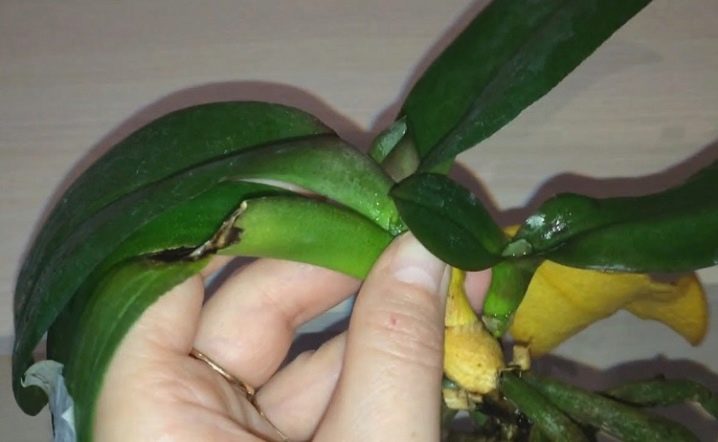
Helpful hints and tips
If you care for orchids correctly, babies will appear on their own. However, you can "awaken a sleeping" bud on a peduncle on your own. For this, the protective scales are carefully removed and the kidney is treated with a special cytokinin paste.The baby, separated from the orchid in time, is already an independent plant, in no way dependent on the mother flower. He will need to provide the same quality care as an "adult" orchid.
It is very important to ensure that the substrate is not overly moisturized. A young orchid should not be watered too vigorously. This plant does not like a lot of moisture and water. Due to the latter circumstance, the roots of the baby may begin to rot. In order not to face such serious troubles, it will be necessary to provide the plants with an ideal moisture level. It is advisable to take water for watering young orchids at room temperature.
In no case should it be too hot or cold. In a different situation, you can seriously harm the sprout.

When buying an orchid in a store, you should find out which subspecies it belongs to. Knowing this, it will be possible to provide the plant with competent and required care, as well as learn the secrets of its flowering and reproduction. If the baby has too small roots, then after transplantation they will most likely develop very slowly, and also be subject to various diseases. In this case, experienced flower growers recommend not to rush to separate the baby, but to wait a little longer until the roots grow to normal size.
Do not forget that it makes sense to wait for new shoots only from healthy and strong plants. Some growers resort to the use of artificial stimulants aimed at the rapid and significant development of the cuttings. The most popular remedy is hormonal cytokinin paste. Care for an orchid baby is required very carefully.
You do not need to be too zealous, since the young shoots of this flower are very vulnerable and capricious. Fertilize the baby also in moderation.

In order for the flower to grow in another pot without problems and be absolutely healthy, it is extremely important to ensure that the new soil has good drainage characteristics. There must also be sufficient air access. Only if these conditions are met, the orchid baby will grow smoothly to the delight of the florist.
Any change in the circumstances of the maintenance for an orchid is a serious stress. That is why this flower is not recommended to be rearranged from place to place, because even this excites a beautiful, but demanding plant. Of course, you can make the orchid more stress-resistant by applying specialized feeding. However, you should not be zealous with them, so as not to harm the flower.
In the room where the orchid baby will be kept, it is recommended to maintain a suitable temperature regime. The optimum will be a temperature value that does not exceed 21 degrees during the daytime.
West or east windows are ideal.
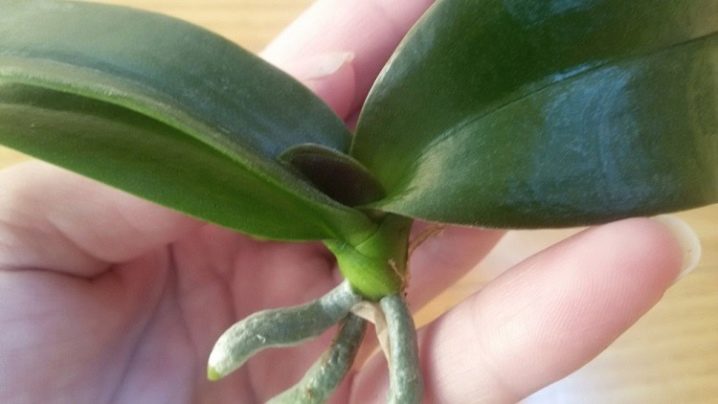
You can find out how to separate the baby from the orchid below.































The comment was sent successfully.